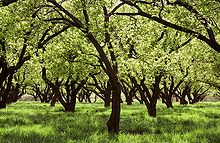Fruita (Utah)
Fruita is a ghost town in Capitol Reef National Park in Utah , United States . It was founded around 1880 by members of the Church of Jesus Christ of Latter-day Saints ("Mormons") under the name Junction and renamed Fruita in 1902. The settlement was abandoned around 1966 and was particularly famous for its orchards , which are maintained to this day.
It is located in the valley of the Fremont River in Wayne County on Utah State Route 24 at about 1,700 m. The orchards, the historic schoolhouse, a log house and a farmhouse with barn and outbuildings have been preserved. With modern facilities there is the campsite of the national park. The park's visitor center and a small settlement for the employees of the park administration are located west of the former village below the striking sandstone formation The Castle .
history
The region in the north of the Colorado Plateau was sparsely populated by Indians of the Fremont culture in prehistoric times . Their culture and the Fremont River are named after John Charles Frémont , who, as an officer in the United States, was the first to survey parts of Utah . Later Paiute Indians lived in the area, but only used them sporadically because of the dry climate.
In the 1870s, members of The Church of Jesus Christ of Latter-day Saints from central Utah also came to the plateau east of the Waterpocket Fault mountain range , now designated as Capitol Reef National Park. Around 1880, the first families settled in the narrow valley of the Freemont River and very quickly began growing fruit. They also grew vegetables and sorghum for the production of molasses . The settlement never had more than ten families. The valley was remote, in 1884 the residents built a horse-drawn carriageway from the mountain valley to Caineville and on to Hanksville , where they brought their fruit to the market throughout the summer or exchanged them directly for other goods.
All residents of Fruita belonged to the church, the "elder" of the community exercised the leadership function in every respect, there was no political organization. Fruita was never registered as an independent place either. The low needs of residents and the remoteness meant that the Great Depression of the 1930s had no impact on the community. Only the designation of the Capitol Reef National Monument (later rededicated in the national park) in 1937 brought changes for Fruita. In 1952 the road through the park area was paved and tourism increased. The federal government made an offer to residents to purchase the private land and by the late 1960s all of it was sold voluntarily.
The National Park Service maintains and looks after the orchards with around 2700 trees (cherries, apricots, peaches, pears and apples) as part of the historical landscape. During harvest time, all visitors can harvest normal household quantities for a small fee.
school
The 1-room schoolhouse with a size of 5.20 x 6 m was built and opened in 1896. The few students were taught mainly reading, writing and arithmetic; but when the teacher felt able he taught other subjects such as history or geography. The room was also used for church services and community celebrations. The building was decommissioned in 1941, listed on the National Register of Historic Places and listed as a Historic Monument in 1964 . Today the condition has been restored in the 1930s. The school can be visited.
Gifford Farm
Historic Gifford Farm is the only remaining working farm. The small farmhouse has been preserved in its condition from the 1960s. The rooms are designed as a museum, a small shop with a café sells books as well as jams, fruit cakes and the like made from the fruits of the orchards. The barn and other outbuildings serve as locations for living history events.
Web links
- National Park Service: Capitol Reef National Park - Redrock Eden: The story of Fruita and the Orchards
Individual evidence
- ↑ The story is largely based on National Park Service: Capitol Reef National Park - Redrock Eden: The story of Fruita and the Orchards
- ^ National Park Service: Orchards
- ^ National Park Service: Fruita Schoolhouse
- ^ Capitol Reef Natural History Association: Gifford House
Coordinates: 38 ° 17 ′ N , 111 ° 15 ′ W




